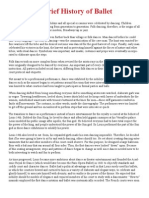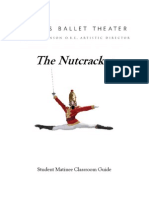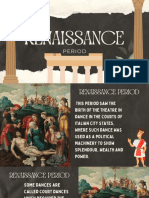0 ratings0% found this document useful (0 votes)
37 viewsBallet Presentation-Group-1 PE
Ballet Presentation-Group-1 PE
Uploaded by
Angelal PogosoBallet is a form of dance that tells stories through graceful movements set to music. Originating in 15th century Italy and France, it developed into a refined art form over centuries. Key events included Louis XIV founding the first ballet academy in Paris in 1661. Romantic ballet rose in the 19th century with ballerinas like Marie Taglioni dancing en pointe. Classical ballet structures stories through movement and music, while modern ballet focuses more on emotion. Famous ballet companies include the Kirov Ballet and Ballet Arizona.
Copyright:
© All Rights Reserved
Available Formats
Download as PPTX, PDF, TXT or read online from Scribd
Ballet Presentation-Group-1 PE
Ballet Presentation-Group-1 PE
Uploaded by
Angelal Pogoso0 ratings0% found this document useful (0 votes)
37 views30 pagesBallet is a form of dance that tells stories through graceful movements set to music. Originating in 15th century Italy and France, it developed into a refined art form over centuries. Key events included Louis XIV founding the first ballet academy in Paris in 1661. Romantic ballet rose in the 19th century with ballerinas like Marie Taglioni dancing en pointe. Classical ballet structures stories through movement and music, while modern ballet focuses more on emotion. Famous ballet companies include the Kirov Ballet and Ballet Arizona.
Original Description:
PE
Original Title
Ballet_Presentation-Group-1_PE
Copyright
© © All Rights Reserved
Available Formats
PPTX, PDF, TXT or read online from Scribd
Share this document
Did you find this document useful?
Is this content inappropriate?
Ballet is a form of dance that tells stories through graceful movements set to music. Originating in 15th century Italy and France, it developed into a refined art form over centuries. Key events included Louis XIV founding the first ballet academy in Paris in 1661. Romantic ballet rose in the 19th century with ballerinas like Marie Taglioni dancing en pointe. Classical ballet structures stories through movement and music, while modern ballet focuses more on emotion. Famous ballet companies include the Kirov Ballet and Ballet Arizona.
Copyright:
© All Rights Reserved
Available Formats
Download as PPTX, PDF, TXT or read online from Scribd
Download as pptx, pdf, or txt
0 ratings0% found this document useful (0 votes)
37 views30 pagesBallet Presentation-Group-1 PE
Ballet Presentation-Group-1 PE
Uploaded by
Angelal PogosoBallet is a form of dance that tells stories through graceful movements set to music. Originating in 15th century Italy and France, it developed into a refined art form over centuries. Key events included Louis XIV founding the first ballet academy in Paris in 1661. Romantic ballet rose in the 19th century with ballerinas like Marie Taglioni dancing en pointe. Classical ballet structures stories through movement and music, while modern ballet focuses more on emotion. Famous ballet companies include the Kirov Ballet and Ballet Arizona.
Copyright:
© All Rights Reserved
Available Formats
Download as PPTX, PDF, TXT or read online from Scribd
Download as pptx, pdf, or txt
You are on page 1of 30
All About
Ballet Dance
Prepared by: Group 1
Angela Pogoso
Joilian Donato
Gigilyn Dela Peña
Nicole Amoranto
Jesus Astrera
Freddie Villas
What is Ballet?
• Ballet is a way of telling a story
using a music and dance instead of
words.
• It consists of patterns movement
which have developed over
centuries.
• Dancers who performed ballet are
highly trained.
• Ballet is found all around the
world, for instance in Europe,
USA, Japan, China and South
America.
Origins of Ballet
The art of Ballet can trace
its origins to the early
seventeenth century,
when dancers performed
to entertain audiences
between scenes of an
opera.
Origins of Ballet
These short dances grew in popularity and
importance until they became a form of theater in
their own right, accompanied by a standardization of
movements and defining of other stylistic
conventions.
History of Ballet
• The history of ballet begins
around 1500 in Italy.
Terms like “ballet” and
“ball” stem from the
Italian word "ballare,"
which means "to dance."
When Catherine de Medici
of Italy married the French
King Henry II, she
introduced early dance
styles into court life in
France.
History of Ballet
• The root of ballet go back more than 100
years. It begun in the Italian nobleman who
sang, danced and recited poems. When
ballet were first performed, men played the
female roles, disguising themselves with
wigs and masks. Women, finally were
allowed to dance publicly in 1681.
• Ballet were spread to the French court.
King Louis XIV, The Sun King
King Louis XIV of
France was by all
accounts a passionate
dancer. He was known
as the Sun King. He
had appeared as the
Sun god, Apollo in Le
Ballet de la Nuit (The
Ballet of the Night), at
the age of 15.
King Louis XIV
• In 1661, King Louis
XIV of France
founded the
Académie Royale de
Musique et de
Danse, establishing
Paris as the center
of academic ballet.
French Court Ballets
Most French court ballets
consisted of dance scenes
linked by a minimum of
plot.
Because they were
designed principally for
the entertainment of the
aristocracy, rich costumes,
scenery, and elaborate
stage effects were
emphasized.
Court Ballet Peak
The court ballet reached its
peak during the reign (1643-
1715) of Louis XIV, whose
title the Sun King was
derived from a role he
danced in a ballet.
Court Ballets
Many of the ballets presented at his court were
created by the Italian-French composer Jean
Baptiste Lully and the French choreographer Pierre
Beauchamp, who is said to have defined the five
positions of the feet.
Also during this time, the playwright Moliere
invented the comedie-ballet, in which danced
interludes alternated with spoken scenes.
The Move to Professional Dancers
Louis XIV stopped dancing in 1670, and his courtiers
followed his example.
By then the court ballet was already giving way to
professional dancing. At first all the dancers were men, and
men in masks danced women's roles.
The first female dancers to perform professionally in a
theater production appeared (1681) in a ballet called Le
Triomphe de l'Amour (The Triumph of Love).
Pointe Shoes
• To enhance the image of
the dancer’s
weightlessness.
• Ballerinas began wearing
Pointe Shoes in the mid-
1800 but shoes had no
support. Pointe shoes were
made famous by ballerina
Anna Pavlova in the 1900s.
What is Tutu?
Tutu is a skirt made of a net fabric called Tule. It
allowed the dancer to show the technique of the
legs and feet on stage.
Romantic Era
The era began with the 1827 début in
Paris of the ballerina Marie Taglioni in
the ballet La Sylphide,
The era marked the rise of
the ballerina as a central part of ballet.
She was one of the most celebrated
ballerinas of the romantic ballet.
Considered to be the first dancer to
dance en pointe.
Known for shortening her skirt in La
Sylphide, which was considered highly
scandalous at the time. Marie Taglioni in La Sylphide
Classical Ballet
Classical ballet is generally structured
on a narrative pretext. It is important
that the audience has an
understanding of the basic story line
so as to fully understand the complex
combination of movement, music and
storytelling that makes up a
performance.
Some ballets, like the Nutcracker or
Sleeping Beauty, are based on
traditional stories that are familiar
even today; others are more obscure
and require a greater effort on the
part of the dancers and the audience
to fully understand their meaning.
Modern Era
• Ballet that are created in this
century.
• They do not always have a definite
story but they have a theme.
• These ballet concentrate more on
emotions and atmospheres and
attempt to arouse the feelings of
the audiences.
• They use the parallel position of
the feet instead of turn out.
• Example of modern ballet-
Firebird (George Balanchine)
Ballet Arizona
• Founded in 1986 as resident ballet company for Arizona
• Directed by Jean-Paul Comelin formally a dancer from
Stuttgart Ballet.
• In 2000, Ib Anderson was named artistic director.
• As a former dancer for New York City Ballet mounted many
Balanchine dances on company.
The Philippine Prima Ballerina
Lisa Teresita Pacheco
Macuja-Elizalde (born
October 3, 1964) is a Filipino
prima ballerina. In 1984, she
became the first foreign
soloist to ever join the Kirov
Ballet.
First Filipino ballerina to win
the silver medal from the
1987 Asia-Pacific Ballet
Competition in Tokyo
The Five Basic Position in
Ballet
Arm Position
Feet Position
Arm and Feet Position
You might also like
- A Brief History of BalletDocument3 pagesA Brief History of BalletSevda Kal SözerNo ratings yet
- Choral Performance: Literature ResourcesDocument16 pagesChoral Performance: Literature ResourcesMelita Arifi100% (1)
- A Brief History of BalletDocument11 pagesA Brief History of BalletccdtbrNo ratings yet
- Lesson 2: Dancing Toward The 21 CenturyDocument37 pagesLesson 2: Dancing Toward The 21 CenturyJuliana Brock0% (1)
- Ballet Beginning - Intermediate Power PointDocument14 pagesBallet Beginning - Intermediate Power PointAna RotoneNo ratings yet
- BalletDocument7 pagesBalletchyantalcbNo ratings yet
- Ballet Beginning - Intermediate Power PointDocument17 pagesBallet Beginning - Intermediate Power PointGabi hilaniNo ratings yet
- HISTORY OF BALLET Ballet Philippines (BP) Is A Ballet Company in The PhilippinesDocument15 pagesHISTORY OF BALLET Ballet Philippines (BP) Is A Ballet Company in The PhilippinesPrecious Joy VillaNo ratings yet
- BalletDocument3 pagesBalletHiep Nguyen KhacNo ratings yet
- Ballet: Discussants: Alay, Angelica Caña, John Bernard Caraan, Gladys Dela Cruz, Jessica Galicinao, LykaDocument15 pagesBallet: Discussants: Alay, Angelica Caña, John Bernard Caraan, Gladys Dela Cruz, Jessica Galicinao, LykaRivera MarianelNo ratings yet
- What Is Ballet?: History of Ballet DanceDocument1 pageWhat Is Ballet?: History of Ballet DanceFiorella Alejandro GalvanNo ratings yet
- Hope 3 BalletDocument29 pagesHope 3 BalletJovi ParaniNo ratings yet
- Modern DancesDocument83 pagesModern Dancessheralynbastillador1No ratings yet
- Ballet Austin Ballet Basics HandbookDocument16 pagesBallet Austin Ballet Basics HandbookClinton Dawson100% (6)
- Dark Blue Green Sport Martial Art PresentationDocument17 pagesDark Blue Green Sport Martial Art Presentationpsagubo199xNo ratings yet
- New InfoDocument17 pagesNew InfoJulius EdillorNo ratings yet
- Student Matinee Study Guide - "Ballet History Trivia and Test Your Knowledge PDFDocument6 pagesStudent Matinee Study Guide - "Ballet History Trivia and Test Your Knowledge PDFMaripili RodriguezNo ratings yet
- The History of BalletDocument23 pagesThe History of BalletSubiksha SundararamanNo ratings yet
- Dansurile Baroce: Louis XIV Din Baletul Le Ballet de La Nuit (1653)Document13 pagesDansurile Baroce: Louis XIV Din Baletul Le Ballet de La Nuit (1653)Danaila MariusNo ratings yet
- Advanced Ballet Unit UpdatedDocument12 pagesAdvanced Ballet Unit UpdatedMaria QuinteroNo ratings yet
- Ballet (Disambiguation) : This Article Is About The Dance Form. For Other Uses, SeeDocument5 pagesBallet (Disambiguation) : This Article Is About The Dance Form. For Other Uses, SeeLynnaNo ratings yet
- Ballet: Ballet Is A Type ofDocument2 pagesBallet: Ballet Is A Type ofschimvoit1No ratings yet
- Module 4Document24 pagesModule 4JC Navarro Dela CruzNo ratings yet
- The Nutcracker Student Matinee GuideDocument16 pagesThe Nutcracker Student Matinee GuidekrparfittNo ratings yet
- What Is Ballet-WPS OfficeDocument11 pagesWhat Is Ballet-WPS OfficeMickaella VergaraNo ratings yet
- Physical Education 3Document22 pagesPhysical Education 3storageacc12918No ratings yet
- In Renaissance Time in Italy Ballet Was The Type of Entertainment On Aristocratic WeddingsDocument3 pagesIn Renaissance Time in Italy Ballet Was The Type of Entertainment On Aristocratic WeddingsDanica ConcepcionNo ratings yet
- A Brief History of BalletDocument12 pagesA Brief History of BalletErich PolleyNo ratings yet
- Modern Dance Story: Late 16Th and 17Th CenturyDocument13 pagesModern Dance Story: Late 16Th and 17Th Centuryannyu178No ratings yet
- Classical Ballet DanceDocument31 pagesClassical Ballet DanceJay CeeNo ratings yet
- Ballet D'Action: Part 1 - Definition and HistoryDocument13 pagesBallet D'Action: Part 1 - Definition and HistorySubiksha SundararamanNo ratings yet
- PE03-S/B/D Learning Material 1 Unit 1-1 TopicsDocument4 pagesPE03-S/B/D Learning Material 1 Unit 1-1 TopicsZiel Arnold MarcosNo ratings yet
- BalletDocument29 pagesBalletGia Kristel Lazaro LopezNo ratings yet
- Petipa, 12th March 2013Document3 pagesPetipa, 12th March 2013wattsbethanyNo ratings yet
- Ballet Dance History PowerpointDocument25 pagesBallet Dance History Powerpointapi-1686353070% (1)
- Ballet Dance History PowerpointDocument25 pagesBallet Dance History Powerpointapi-168635307No ratings yet
- History and Nature of BALLETDocument17 pagesHistory and Nature of BALLETJasmine Elle Estrada GuevarraNo ratings yet
- The Great Leap From Earth To Heaven: The Evolution of Ballet and Costume in England and France in The Eighteenth CenturyDocument25 pagesThe Great Leap From Earth To Heaven: The Evolution of Ballet and Costume in England and France in The Eighteenth CenturyLjubica VelkovaNo ratings yet
- BalletDocument8 pagesBalletapi-267083617No ratings yet
- Ballet.: Dance Ballet de CourDocument52 pagesBallet.: Dance Ballet de CourCirstea NicoletaNo ratings yet
- "Dance Is The Hidden Language of The Soul"Document19 pages"Dance Is The Hidden Language of The Soul"SariMinHoNo ratings yet
- PE MergedDocument35 pagesPE MergedJulie CabusaoNo ratings yet
- Dance History Timeline: Classical Persian Dancing First DancingDocument4 pagesDance History Timeline: Classical Persian Dancing First DancingCherry Doong CuantiosoNo ratings yet
- Ballroom DanciinngggDocument4 pagesBallroom DanciinngggAngela Bainca AmperNo ratings yet
- Dance Forms Lesson 13Document8 pagesDance Forms Lesson 13nosjay 16No ratings yet
- Ballet Is A Type ofDocument1 pageBallet Is A Type ofAlexandra RomanNo ratings yet
- Dance 460 Ballet Research PaperDocument10 pagesDance 460 Ballet Research Papercalius1No ratings yet
- Unit I: Overview: Acquire New KnowledgeDocument19 pagesUnit I: Overview: Acquire New KnowledgeGeraldine Collado LentijaNo ratings yet
- Giselle La Sylphide: Pointe WorkDocument2 pagesGiselle La Sylphide: Pointe Workchris rosalesNo ratings yet
- MODULE 3 Dance Towards The 21st CentruyDocument7 pagesMODULE 3 Dance Towards The 21st Centruygarciakirk9No ratings yet
- BalletDocument6 pagesBalletCleah Fil SinarillosNo ratings yet
- BallroomDocument2 pagesBallroomJane TodjancoNo ratings yet
- History of Dance and Ballet Alongside MusicDocument16 pagesHistory of Dance and Ballet Alongside MusicPlatoNo ratings yet
- Renaissance PeriodDocument18 pagesRenaissance PeriodNATHANIEL CORTEZNo ratings yet
- College of Engineering, Architecture and TechnologyDocument9 pagesCollege of Engineering, Architecture and TechnologyESCALADA, CRISTINE JOY, S.No ratings yet
- Presentation 2Document36 pagesPresentation 2Shiela Mae MartinezNo ratings yet
- Ballroom Dance: Znyx Aleli Mariano Bse-Filipino 1Document10 pagesBallroom Dance: Znyx Aleli Mariano Bse-Filipino 1Mariano, Znyx Aleli J.No ratings yet
- Pe ReviewerDocument3 pagesPe ReviewerlailahNo ratings yet
- Erica ThesisDocument78 pagesErica ThesisAngelal PogosoNo ratings yet
- Math Quiz 1 AnswerDocument7 pagesMath Quiz 1 AnswerAngelal PogosoNo ratings yet
- My ReportDocument85 pagesMy ReportAngelal PogosoNo ratings yet
- Group 5 Assessmemt ReportDocument36 pagesGroup 5 Assessmemt ReportAngelal PogosoNo ratings yet
- Facilitating ReportDocument7 pagesFacilitating ReportAngelal PogosoNo ratings yet
- Pe Report 111320Document17 pagesPe Report 111320Angelal PogosoNo ratings yet
- CCT AngelaDocument2 pagesCCT AngelaAngelal PogosoNo ratings yet
- History of Folk Dance - 111524Document19 pagesHistory of Folk Dance - 111524Angelal PogosoNo ratings yet
- Ne Me Quitte Pas - Jaques BrelDocument1 pageNe Me Quitte Pas - Jaques BrelEbi0% (1)
- Philippine Folk Dances InfographicDocument1 pagePhilippine Folk Dances InfographicJaypee AustriaNo ratings yet
- Gorillaz - Clint EastwoodDocument3 pagesGorillaz - Clint Eastwoodfralab3132No ratings yet
- Rindo Da Saudade: Transcribed By: Diogo CarvalhoDocument4 pagesRindo Da Saudade: Transcribed By: Diogo CarvalhoNazareno ColliniNo ratings yet
- BA UoE Unit 5 PDFDocument22 pagesBA UoE Unit 5 PDFMaricarmen YaltaNo ratings yet
- Sidhu Moose Wala - WikipediaDocument1 pageSidhu Moose Wala - WikipediaAman GuptaNo ratings yet
- Composers of Medieval, Renaissance, and Baroque PeriodDocument4 pagesComposers of Medieval, Renaissance, and Baroque PeriodRodnie RafaelNo ratings yet
- Yoasobi - Yoru ni Kakeru: 作曲: Ayase 採譜: scarletzyyDocument3 pagesYoasobi - Yoru ni Kakeru: 作曲: Ayase 採譜: scarletzyyakito 1109-37No ratings yet
- Medieval, Renaissance, & Baroque MusicDocument42 pagesMedieval, Renaissance, & Baroque MusicJoana PayasNo ratings yet
- Conducting Tips - Jude NwankwoDocument5 pagesConducting Tips - Jude NwankwoOdogwu BittersNo ratings yet
- Prokofiev's Sinfonia ConcertanteDocument35 pagesProkofiev's Sinfonia ConcertantebobocelloNo ratings yet
- Grade 7 Music and Arts - 4th QuarterDocument12 pagesGrade 7 Music and Arts - 4th Quartercean100% (1)
- Violin Practical Grade 1 2020 2023 August 2021 UpdateDocument19 pagesViolin Practical Grade 1 2020 2023 August 2021 UpdateIlva Haxhiu100% (1)
- Exercises: Part A: FundamentalsDocument3 pagesExercises: Part A: FundamentalsNikos KNo ratings yet
- Korean MusicDocument2 pagesKorean MusicRosalouise P. UngabNo ratings yet
- Musical Analysis of Stella SplendensDocument10 pagesMusical Analysis of Stella SplendensScribdTranslationsNo ratings yet
- Theater Kithara: Reading TragedyDocument4 pagesTheater Kithara: Reading TragedyOtávio de Melo0% (1)
- Aa Finals ReviewerDocument24 pagesAa Finals ReviewerMichyll KyutNo ratings yet
- Basse Dance "Patience" 18 Basses Dances, 1529 Intabulated by Wayne CrippsDocument1 pageBasse Dance "Patience" 18 Basses Dances, 1529 Intabulated by Wayne CrippsJose AkelNo ratings yet
- Music 6-Q3-W1Document19 pagesMusic 6-Q3-W1vinnNo ratings yet
- María Cristina Kiehr Jonatan Alvarado Ariel Abramovich: Soprano Tenor VihuelaDocument17 pagesMaría Cristina Kiehr Jonatan Alvarado Ariel Abramovich: Soprano Tenor Vihuelalafenice83No ratings yet
- Fundamental Concepts in William Caplin's Theory PDFDocument5 pagesFundamental Concepts in William Caplin's Theory PDFScribdTranslationsNo ratings yet
- Horn Syl Lab Us Complete 13Document17 pagesHorn Syl Lab Us Complete 13Jennifer LaiNo ratings yet
- Villa-Lobos - Floresta Amazônica (Completa)Document18 pagesVilla-Lobos - Floresta Amazônica (Completa)Pedro PanilhaNo ratings yet
- Piano Chords Ebook For Beginners - Skillshare PDFDocument25 pagesPiano Chords Ebook For Beginners - Skillshare PDFShaun Sunil OfficialNo ratings yet
- Taylor Swift - Question... Lyrics Genius LyricsDocument1 pageTaylor Swift - Question... Lyrics Genius LyricsRafa VianaNo ratings yet
- Don Gil de AlcaláDocument11 pagesDon Gil de AlcaláEduardo Gallego BallesterosNo ratings yet
- Physical Education and Health Week 9-10, Quarter 1, Module 4Document2 pagesPhysical Education and Health Week 9-10, Quarter 1, Module 4Ram MejiaNo ratings yet
- Ciudad Del Lago Marinera Modificado 2020Document2 pagesCiudad Del Lago Marinera Modificado 2020yesica flores apazaNo ratings yet

































































































